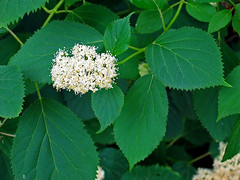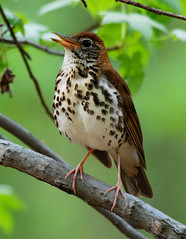Plants and Animals
Learn More
Other Websites
Explore this page
Plants
The Mesic Mixed Hardwood Forest, with its rolling landscape, has a peaceful, open feel—the forest floor sparsely accented with green Christmas fern under the lovely sweeping limbs of smooth-trunked American beech trees, soaring tuliptrees, and oaks. It can be striking in autumn because of the mix of leaf colors in the canopy and understory. The field layer in this community lacks the rich diversity of plants (such as spring wildflowers common in the more fertile Basic Mesic Hardwood Forest).
The single most common tree species—whether mature, sapling, or seedling—in this forest is often American beech. Look for the yellow-turning-to-tan leaves dangling from American beech trees’ horizontal limbs deep into winter.
Why so many large American beech trees in the Mesic Mixed Hardwood Forest in Rock Creek Park? It may be due, in part, to the fact that historically oaks were a preferred timber species. Selectively cutting oaks (and possibly American chestnut) from the forest made room for young understory American beech trees to grow up into and dominate the canopy. Today when white-tailed deer munch on the tasty leaves and twigs of young oaks (a preferred food choice), they are effectively pruning back the oak regrowth!
Canopy Trees
The trees whose crowns intercept most of the sunlight in a forest stand. The uppermost layer of a forest.
- American beech
- northern red oak
- tuliptree
- white oak
- black oak (occasional)
- chestnut oak (occasional)
- white ash (occasional)
A mix of deciduous hardwood species—American beech, tuliptree, white oak, and sometimes northern red oak—are the most common trees in the canopy of the Mesic Mixed Hardwood Forest.
Understory Trees
Small trees and young specimens of large trees growing beneath the canopy trees. Also called the subcanopy.
- American beech
- American holly
- American hornbeam
- blackgum
- flowering dogwood
- mockernut hickory
- red maple
- eastern redbud (occasional)
- sassafras (occasional)
Mockernut hickory, red maple, and blackgum frequently grow beneath the canopy trees. At Rock Creek Park, if you see much American holly, you most likely are standing in the Mesic Mixed Hardwood Forest; this small evergreen tree grows well on the acidic, well-drained soils here. Look for its dark green, sharply pointed leaves in winter and fall, when most other trees have lost their leaves.
Other small trees common in the understory are the beautiful flowering dogwood and American hornbeam (sometimes called musclewood for the smooth, muscular, rippled appearance of its trunk).
Shrubs, Saplings, and Vines
Shrubs, juvenile trees and vines at the right height to give birds and others a perch up off the ground but below the trees.
- mapleleaf viburnum
- wild grapes
- American chestnut saplings (occasional)
- American witch-hazel (occasional)
- black cherry saplings (occasional)
- common serviceberry (occasional)
- eastern poison-ivy (occasional)
- greenbriers (occasional)
- northern spicebush (occasional)
- pawpaw (occasional)
- Virginia creeper (occasional)
The spindly mapleleaf viburnum shrub is nearly always present in the Mesic Mixed Hardwood Forest, sometimes in great quantity. Although mountain laurel and hillside blueberry are not characteristic of this community, they may occasionally be found on slightly drier, convex slopes. This layer is fairly diverse compared with that of other, drier natural communities found on hilltops with gravelly soil, or on steeper slopes (Chestnut Oak / Mountain Laurel Forest, Mixed Oak / Heath Forest, or Oak – Beech / Heath Forest). However it may be sparse in places due to excessive deer browse, especially where the slope is convex and thus drier.
Low Plants (Field Layer)
Plants growing low to the ground. This includes small shrubs and tree seedlings.
- broadleaf enchanter’s-nightshade
- Christmas fern
- hairy sweet-cicely
- Jack-in-the-pulpit
- American cancer-root (occasional)
- beechdrops (occasional)
- cutleaf toothwort (occasional)
- hog-peanut (occasional)
- Indian cucumber (occasional)
- Indian-pipe (occasional)
- mayapple (occasional)
- New York fern (occasional)
- sedges (occasional)
- Solomon’s plume (occasional)
- Virginia springbeauty (occasional)
- white wood-aster (occasional)
- wild yam (occasional)
A common plant in the field layer is the Christmas fern, which deer find distasteful. A fascinating little parasitic plant that grows under American beech trees is beechdrops, sporting tiny wine-colored flowers in late summer and early fall. This plant has no leaves, instead drawing nutrients from the roots of American beech. It can tolerate deep shade since it has no need for sunlight for photosynthesis.
Though lots of plant species are possible here, most are only sparsely or even uncommonly seen, especially where hungry deer hang out, or where the soil is drier on the convex curve of slopes.
Non-Native Invasive Plant Species
Oriental bittersweet*, Japanese barberry*, Japanese honeysuckle*, and linden arrow-wood* are some of the many non-native invasive species that have invaded the Mesic Mixed Hardwood Forest in Rock Creek Park. Read about them in Ecological Threats.
Notable Variations
 Wild hydrangea (Hydrangea arborescens) flowering in June.
Wild hydrangea (Hydrangea arborescens) flowering in June.
Photographer: Gary FlemingSome rock outcrops in the Mesic Mixed Hardwood Forest (but mostly in the Oak – Beech / Heath Forest) are occupied by a completely different set of plants (a “miniature natural community” of sorts) that can thrive in almost no soil at all, such as the “hydrangea rock gardens” in Rock Creek Park. This small but notable “community” of plants includes wild hydrangea, growing in the nooks and crannies of scattered rock outcrops. You can see the distinctive white blooms of the hydrangea shrub in July, and its toothed, dark-green, egg-shaped leaves the rest of the year. Other plants grow in small pockets of soil within cracks in these rock outcrops—marginal woodfern, white wood-aster, New York fern, and violets, among others. Because of the extremely limited soil, this community cannot support trees, but only small shrubs and herbs. Keep an eye out for isolated pockets of "hydrangea rock gardens" tucked here and there in outcrops of bedrock beside Valley Trail on the upslope side (a good landmark from Valley Trail, visible across Rock Creek, is Picnic Area 8).
Map tip: To find these natural highlights, go to the interactive map of Rock Creek Park, and search for "hydrangea."
Animals
 Wood thrush (Hylocichla mustelina), Washington, D.C.'s official bird.
Wood thrush (Hylocichla mustelina), Washington, D.C.'s official bird.
Photographer: Bill LynchAlmost any land animal that lives at the park can be seen in the Mesic Mixed Hardwood Forest. You may see animals such as white-tailed deer, gray squirrels, and chipmunks, along with pileated, red-bellied, and downy woodpeckers, wood thrushes, chickadees, warblers, veeries, grackles, flycatchers, Baltimore oriole, and possibly even a coyote, fox, or a beneficial black rat snake.
During spring, listen for the melodic wood thrush song. Listen for the trill of the eastern screech-owl or look for their nest cavities in tall oak, American beech or tuliptree. Though the cavity may look like a pileated woodpecker hole, it could belong to a pair of eastern screech-owls; by late spring or summer, you will know whether owlets have been born by their characteristic screeching for food.
In the fall, you may see long, stringy, white woolly masses of the "Boogie-Woogie Aphid" on American beech twigs. Ecobit: The Boogie-Woogie Aphid



